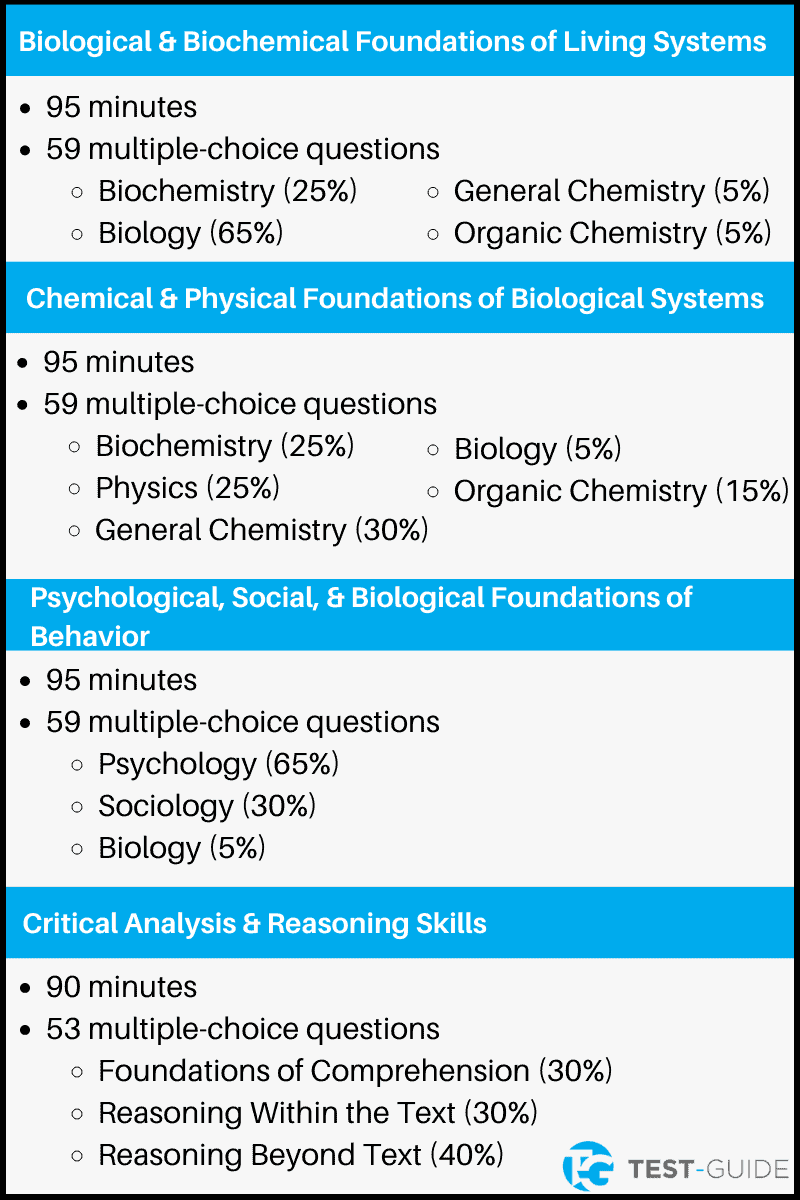Take our free MCAT practice test below to prepare for your exam.
Our MCAT practice questions mimic actual exam questions and include detailed answer explanations to help you learn important concepts.
Start Practicing
Choose your MCAT practice test by subject below. We have split them into different sections, just like the actual MCAT.
Biological and Biochemical Practice Exams
Chemical and Physical Foundations Practice Exams
Psychological, Social, and Biological Foundations Practice Exams
- Psychological, Social, and Biological Foundations Practice Test 1
- Psychological, Social, and Biological Foundations Practice Test 2
Critical Analysis and Reasoning Practice Exams (CARS)
Make sure to review the answer explanations at the end of each MCAT practice test. If you want more help, consider one of the best MCAT prep courses.
Additional MCAT Practice Resources
If you want some more MCAT questions and resources to help you study, check out the table below.
| Resource | Provider |
|---|---|
| Biological and Biochemical Questions | Quizlet |
| Chemical and Physical Foundations Questions | Quizlet |
| Psychological, Social, and Biological Foundations Questions | Quizlet |
| CARS Study Material | Quizlet |
MCAT Sample Questions
In order to provide you with a better understanding of MCAT practice questions, we have provided you with some example questions.
Question #1
Category: Biological and Biochemical Foundations
Question: A scientist using mouse models to determine the response of blood hormones to large levels of glucose in the body discovers a new hormone not previously described.
According to his data, this hormone is found both inside and out of cells when carrying out its function, increase the amount of nucleic acid in the cell while functioning, and are derived from a structure containing four hydrocarbon rings.
This will likely be categorized as which type of hormone?
- Enzymatic
- Steroid
- Peptide
- Amino Acid
Answer: B. Steroid hormones, derived from cholesterol, act on intracellular receptors and produce mRNA specific to the outcome they produce. Thus, they are found both inside and out of the cell.
Peptide hormones, such as insulin, act on outer membrane receptors, but are polarized, so they cannot enter the cell. Amino acid hormones can have the ability to enter the cell, but are usually made up of very small combinations of amino acids, and never of cholesterol, a four hydrocarbon ring.
Question #2
Category: Chemical and Physical Foundations
Question: One of the many reasons that the eukaryotic cell can possess so much information in its DNA is the ability to condense coding regions when they are not being expressed. When acting on DNA, which of the following processes will usually lead to a decrease in gene expression?
- Increased histone acetyltransferase activity
- Decrease in histone deacetyltransferase activity
- Increase in methylation activity
- Increase in heterochromatin:euchromatin ratio
Answer: C. This is a straightforward question that assesses knowledge of modification of DNA segments. Although in the real world these methods are not exclusive to increasing or decreasing activity, for MCAT testing purposes, histone acetyltransferase (HAT) frees DNA from histone proteins for expression.
Histone deacetyltransferase (HDAC) binds DNA more tightly to histone, creating more heterochromatin, which is not expressed. Methylation is an epigenetic modification that generally trends toward silencing gene expression.
Question #3
Category: Psychological, Social, and Biological Foundations
Question: A patient comes into the ER looking extremely agitated. They are acting aggressive, and claiming they need medication or “bad things will happen”. What is the likely state of this patient’s dopamine system?
- There is decreased dopamine in the synaptic cleft.
- There are decreased dopamine receptors on the post-synaptic membrane.
- There is cell death in the areas with high dopamine cells.
- There is seizure-like activity in the dopamine brain areas.
Answer: B. This question comes off much like a biology question, but is actually a first-level derivative of a psychology/behavior question testing the concept of tolerance. Long-time stimulant drug users have excessive amounts of dopamine in the synaptic cleft due to inhibition of re-uptake.
Because of this, the body responds by decreasing the amount of available receptors. This leads to tolerance, or the individual needing more drug to maintain the same level of physiological response. A person in withdrawal likely has a high tolerance built up over an extended period of drug use.
Overview of the MCAT
There are 4 different sections on the MCAT. Those sections are:
- Chemical and Physical Foundations of Biological Systems: 59 questions, 95 minutes
- Critical Analysis and Reasoning Skills (CARS): 53 questions, 90 minutes
- Biological and Biochemical Foundations of Living Systems: 59 questions, 95 minutes
- Psychological, Social, and Biological Foundations of Behavior: 59 questions, 95 minutes
You can learn more about the exam with our MCAT overview guide.
Studying for the MCAT
Here are some tips and steps you can take when studying for the MCAT exam.
- Take a Diagnostic Exam: A diagnostic exam should be taken at the beginning of your MCAT studies. A diagnostic exam will show you what score you would get if you took the exam today – it is a great way to get a baseline.
- Do Not Focus on Memorization: When taking this exam, you will be asked to apply basic knowledge to various situations – some of these situations could be completely new.
- Nail Down Concepts First: Focus on learning the core concepts first and then focus on the timing aspect of the exam.
- Improve Focus: The MCAT is a 7+ hour exam. You will need to have laser-sharp focus for these 7+ hours.
- Use Full-Length Practice Exams: Taking multiple full-length exams will help improve you focus and help you better prepare for the amount of time it takes to finish the exam.
- Utilize Answer Explanations: Answer explanations will help you better understand the material and learn why an answer was right or wrong.
- Evaluate Your Progress: It is important to take a step back and evaluate your progress while studying for the MCAT. Make tweaks to your study plan as necessary. Everyone is different and will have a different process.
- Manage Your Workload: Do not cram for the exam. Try to avoid burnout by spreading your studying out over multiple months.
Benefits of Using a MCAT Practice Test
A MCAT practice test has many benefits. Some of the benefits include:
- Familiarity with the Exam: You will get a better feel for the types of questions asked on the exam by taking a practice test.
- Familiarity with Timing: You will become more comfortable with the timing of the exam by practicing MCAT questions.
- Narrow Down Problem Areas: You can use a practice test to narrow down the sections of the exam you struggle most with. You can then focus on those sections when using your test prep.
Frequently Asked Questions
What is the MCAT?
MCAT stands for Medical College Admissions Test. This exam is used by medical schools in the United States when determining admissions for prospective students. The exam is multiple-choice and is administered by the American Association of Medical Colleges (AAMC).
Is the MCAT all multiple-choice?
The MCAT is all multiple-choice questions.
How long is the MCAT?
The exam is 7 hours and 30 minutes long. You will be actually testing for 6 hours and 15 minutes.
How much does the MCAT cost?
The standard fee to take the MCAT is $335. Here is additional information on fees.
How do you register for the MCAT?
You will need to register through the AAMC website. You can read more about MCAT test dates and registration information.
Can you use a calculator on the MCAT?
Test takers may not use a calculator on the MCAT. All calculations are expected to be done by hand. It is best to not use a calculator when taking free MCAT practice exams.
How many practice tests should I take for the MCAT?
You should take at least 3 MCAT practice tests before taking the actual exam. The first one should be your MCAT diagnostic test. This should give you a better idea of what you know and what you need to focus on.
The second practice exam should be halfway through your studies. You should see some progression from your diagnostic exam. Continue to focus on the topics you struggle on.
The final MCAT practice exam should be once you feel you have completed your studies and are getting close to the actual test day. If you are still uncomfortable after taking this exam, keep studying and take more practice exams.
How many times can you take the MCAT?
You are able to take the MCAT 7 times in your lifespan. You can take the exam up to 3 times during a single testing year and 4 times during a two-consecutive year period.


